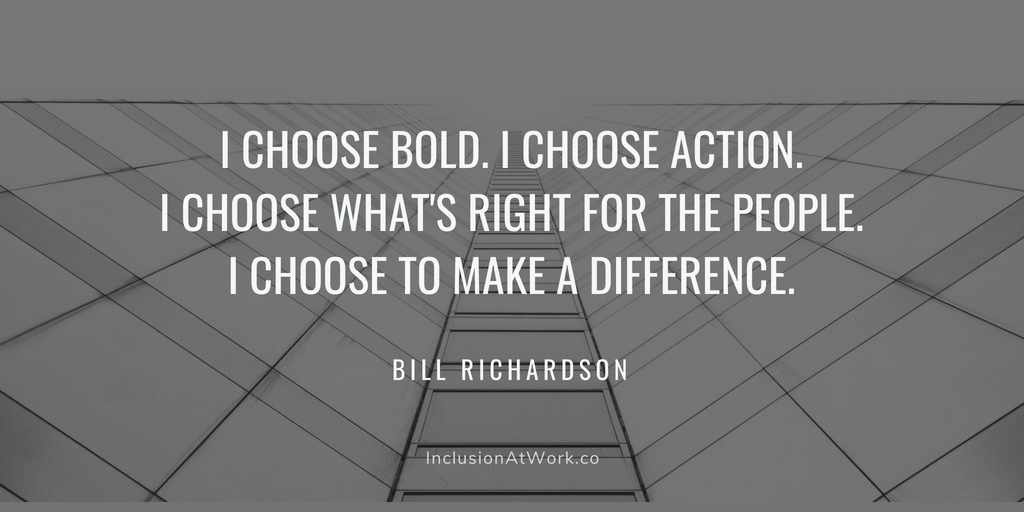"But whyyy do we have to do all this diversity stuff?"
"How do you address skeptics when you're trying to build for inclusion?"

Submit your own question about Diversity & Inclusion here and subscribe to weekly posts here!
∗ ∗ ∗
Dear Inclusion At Work,
The leaders at my startup are pretty bought into the idea of diversity and agree that this is important. But a few people are pretty skeptical, and they’re not trying very hard to hide it. There’s a small group of people making some noise, implying there’s “too much talk about diversity.” The complaints are kind of under the radar still, but I’m afraid any diversity initiatives that my team rolls out are going to get picked apart.
The rumblings are from men, but so are some of the leaders most committed to diversity. How do you deal with people who just don’t seem to care?
-Fighting the Skeptics
Dear Fighting the Skeptics,
I want to share a similar story from my last startup about getting people on the same page with diversity programs. It’s a longer story, but I promise the lessons are so relevant!
In 2015 we were were around 50 people and had just formalized our first ERG (Employee Resource Group) for women. The group had started as a small dinner every few months. As the number of women in the company grew, we created a Slack channel that was primarily used for sharing articles and events.
Soon after that, a male employee nervously pulled me aside. He’d just been added to a new private Slack channel that had made him uncomfortable. He opened his laptop to #dudes, which included a majority of the men in the office. Its tagline, “The women have a channel, so it’s only fair.”
🤔
On one hand, creating a Slack channel didn’t break any explicit rules, especially since the messages didn’t say much. They were mostly along the lines of, “Hey dudes,” “What up my man,” “DUDESSSSSS.” But it was the subtext that was problematic – a tone that could have been interpreted as mocking, or putting forward a “us vs. them” mentality. In hindsight, we’d clearly missed some steps in the implementation of the ERGs that caused some misunderstanding, and could potentially undermine the whole effort.
I enlisted the help of one of the male founders, Randal, to work through our strategy to investigate and shut down not only #dudes, but also any of its future iterations.
First, Randal approached the creator of the group for a 1:1 conversation, to truly understand the intent and to make sure we weren’t making any assumptions. The instigator admitted it was just supposed to be a joke and he just hadn’t thought very much about it. Randal firmly, but kindly drew a line and explained why this went against our goals for an inclusive culture.
Second, we addressed the issue at All-Hands the next day, where Randal opened it up with a story of his own: “Last year, when the first women’s dinner happened with just 4 women, I made a joke too: ‘Oh if you’re doing that, maybe I’ll grab some engineers and get some pizza or something.’” Only after I talked to some folks, I realized that I messed up, and what I said wasn’t cool.”
He continued, “There was a reason why that group exists in the first place. Women might not be technically a minority, but they are underrepresented in our industry. Because of that, they face challenges and biases that I can never fully understand.”
You could have heard a pin drop in that room, the whole company was paying rapt attention. That’s why everyone was able to hear the further explanation, that the women’s dinners were not about cocktails and talking about nail polish or whatever. ERGs, in general, exist to support team members from marginalized groups. They are a place for sharing stories and experiences, and ERGs are positively correlated with employee engagement and retention. “That is something that the company is proud to support,” Randal concluded.
Afterwards, in person and in Slack, many folks expressed their gratitude for the leadership’s authenticity and transparency. I also think this incident contributed to the cultural foundation that enabled the D&I work far beyond our first ERG and gender issues. (More stories about that in future columns - subscribe!)

I’ve since gotten to reflect on how impactful it was, in having a founder open up with an admission of his own past mistake. Often, mention of diversity trigger worries about yourself and what you're missing out on. ‘That sounds fun! Why can’t I have that too?’ (Amy Nguyen has a brilliant articulation of what to do when you feel left out of programs and resources.) This is why it was so important for Randal to acknowledge that human impulse upfront. It set the stage to more directly address the issue.

Ok! I know this was a long story, but it provides for some good lessons that I want to pull out:
- If you see something, say something. This is a key D&I principle for a reason. The incident might have gone a whole different way if it wasn’t for the male employee who first raised a flag about #dudes, almost immediately after it was created. Most allies underestimate the power they have to hold others accountable simply by speaking up. It takes courage and vulnerability, but standing up for what’s right is always worth it.
- When things go wrong, address it head-on. It’s not fun to go into All-Hands and talk about uncomfortable incidents. But drawing a line that says, “we don’t do that here,” is critical. People will remember, and these acts of emotional bravery get embedded into the culture as you grow.
- Leverage what you have. In Randal, we had an emotionally-intelligent founder who not only listened empathetically, but was able to respond with authority. There are also just some things that a male ally like him could say, that I, as a woman, couldn't. Figure out who your Randal is and enlist their help – don’t take on D&I alone.
- If you’re any kind of a leader, D&I is part of your responsibility. Most underrepresented minorities (URMs) are all too familiar with this: “The guys are just joking, maybe you’re being too sensitive.” Attacking the messenger is an unfortunately common response from leaders who ‘just don’t want to deal with this diversity stuff.’ Leaders, please take note: by shutting down URMs’ concerns, you’re actually making your job harder in the long run. Instead, listen and be appreciative when someone brings up a concern with you. It means they hope you can help, and if you lose that trust, you may never get it back.
- You don’t have to be afraid of criticism. In fact, you should expect it. No D&I program will ever be perfect. Any kind of organizational change rocks the boat, and there will always be some skeptics. But sometimes, the critics are trying to tell you something in your blindspot. Although the delivery is probably less tactful than you’d like, you can still find value in it. The key is to discern whether the criticism is given in good faith and from a place of care. For those who just want to tear things down – yeah, we don’t have time for that. Hopefully, that’s when your leaders can throw down their weight.
- Communicate, communicate, communicate. The most important lesson from this story was actually a very personal one for me. In forming our first ERG, I hadn’t been clear and open enough about the purpose and process behind it. At the time, I didn’t feel like I knew I was doing (classic Impostor Syndrome), and the lack of transparency had led to understandable confusion among some of the male colleagues. When people feel left out of information, they often fill in the gaps with negative interpretations. This goes double for diversity efforts. Don't assume people know your intent or have the context of your actions – and that’s true for pretty much everything we do.

There are few hard and fast rules in D&I. This work is messy and ambiguous, and the criticism and skepticism will never fully cease.
But you don’t have to let the haters stop you from doing what’s important. Just remember that if you’re serious about inclusion at work, you’ll need to be open about your intentions and rally allies and leaders of all kinds. That was a lesson that #dudes taught me, and I’ve tried to never forget.
I hope you find some valuable lessons in this story, Fighting the Skeptics. Realistically, you might never get 100% of your team fully enthusiastic about D&I, but the work isn't about it always being fun. It’s the right thing to do, so utilize every opportunity to inch forward.
Yours,
Jen
If you liked this post, please consider sharing it! 🙏
Further reading
Advice for Responding to Backlash Against Minority Outreach Programs by Amy Nguyen
Common Obstacles in D&I - how to address them without getting discouraged & How to talk about sensitive topics around D&I at work from me!
Thanks to Bukky Adebayo and Marek Zareba for edits! Also to my former colleagues Randal, Kiran, Amelia, and the ally who first raised the flag 💛
Photo by Priscilla Du Preez on Unsplash

